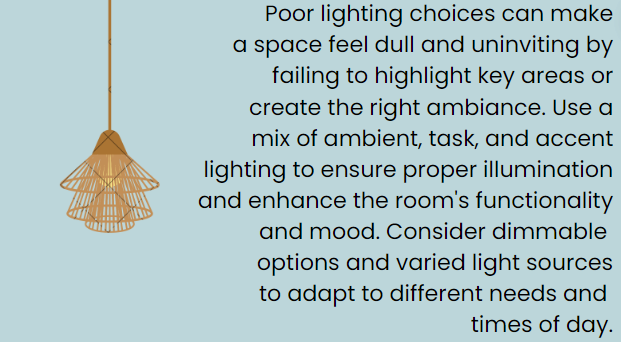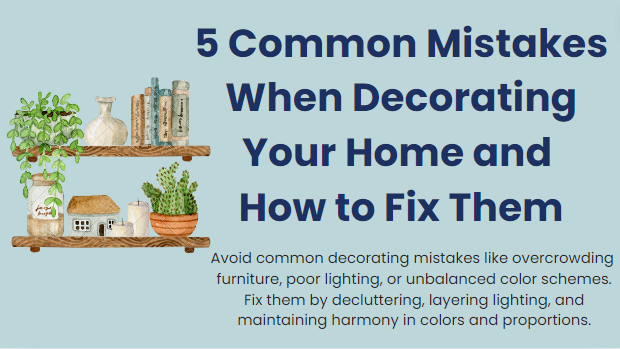Are you frustrated with your home’s decor? Do you feel like something’s off but can’t quite put your finger on it? You’re not alone. Many homeowners make common decorating mistakes that can throw off the entire aesthetic of their living spaces. In this article, we’ll explore five of the most frequent decorating faux pas and provide practical solutions to help you transform your home into a stylish and harmonious haven.
1. Ignoring Scale and Proportion
One of the biggest mistakes people make when decorating their homes is neglecting the importance of scale and proportion. This oversight can lead to rooms that feel awkward, unbalanced, or simply “off.”
Common pitfalls:
- Choosing furniture that’s too large or small for the room
- Hanging artwork at the wrong height
- Using area rugs that are too small for the space
How to fix it:
- Measure your room and create a floor plan before purchasing furniture
- Follow the “2/3 rule” for selecting area rugs: the rug should cover about two-thirds of the room’s floor space
- Hang artwork at eye level (approximately 57-60 inches from the floor to the center of the piece)
| Furniture Item | Ideal Sizing Guide |
|---|---|
| Sofa | 2/3 the length of the wall it’s placed against |
| Coffee Table | 2/3 the length of the sofa |
| Dining Table | 36 inches of clearance on all sides |
By paying attention to scale and proportion, you’ll create a more balanced and visually pleasing space that feels cohesive and well-thought-out.
See also>> How to Make Time for Hobbies in a Hectic Schedule
2. Poor Lighting Choices
Lighting can make or break a room’s ambiance, yet it’s often an afterthought in home decorating. Inadequate or harsh lighting can create an uninviting atmosphere and even affect your mood.
Common pitfalls:
- Relying solely on overhead lighting
- Neglecting task lighting in functional areas
- Choosing light fixtures that don’t complement the room’s style
How to fix it:
- Implement a layered lighting approach using ambient, task, and accent lighting
- Use dimmer switches to control light levels and create different moods
- Choose light fixtures that match your decor style and complement the room’s proportions
Remember, good lighting enhances the overall aesthetic of your space and improves functionality. Don’t be afraid to experiment with different light sources and fixtures to find the perfect balance for each room.

3. Neglecting Color Coordination
Color plays a crucial role in home decor, influencing mood, perception of space, and overall aesthetic. Many homeowners struggle with color coordination, leading to rooms that feel disjointed or overwhelming.
Common pitfalls:
- Using too many competing colors
- Failing to consider the room’s natural light when selecting colors
- Neglecting to create a cohesive color scheme throughout the home
How to fix it:
- Start with a neutral base and add pops of color through accessories
- Use the 60-30-10 rule: 60% dominant color, 30% secondary color, and 10% accent color
- Consider the room’s function and desired mood when selecting colors
- Create a cohesive flow by using complementary or analogous color schemes throughout your home
| Color Scheme | Description | Example Colors |
|---|---|---|
| Monochromatic | Various shades of a single color | Light blue, navy, royal blue |
| Complementary | Colors opposite on the color wheel | Purple and yellow |
| Analogous | Colors adjacent on the color wheel | Green, yellow-green, yellow |
By mastering color coordination, you’ll create a harmonious and visually appealing environment that reflects your personal style and enhances your home’s overall aesthetic.
4. Overcrowding Spaces
In the excitement of decorating, it’s easy to fall into the trap of overcrowding your spaces. This mistake can make rooms feel cluttered, chaotic, and smaller than they actually are.
Common pitfalls:
- Filling every available surface with decor items
- Cramming too much furniture into a room
- Neglecting to create negative space
How to fix it:
- Embrace the “less is more” philosophy
- Create focal points in each room and arrange furniture and decor around them
- Regularly declutter and rotate decor items to keep spaces fresh
- Incorporate multi-functional furniture to maximize space efficiency
Remember, negative space is just as important as the objects in a room. It gives the eye a place to rest and can make a space feel more open and inviting. Don’t be afraid to leave some walls and surfaces bare – it can actually enhance the overall design of your home.

See also>> Packing Light: What to Bring for Any Trip
5. Ignoring Personal Style
One of the most significant mistakes in home decorating is prioritizing trends over personal style. This can result in a home that looks great on paper but feels impersonal and disconnected from its inhabitants.
Common pitfalls:
- Copying designs from magazines or social media without considering personal preferences
- Neglecting to incorporate meaningful personal items into the decor
- Sacrificing comfort for style
How to fix it:
- Start by identifying your personal style through mood boards or online quizzes
- Incorporate cherished personal items and family heirlooms into your decor
- Mix different styles to create a unique look that reflects your personality
- Prioritize comfort and functionality alongside aesthetics
| Style Element | Personal Touch Ideas |
|---|---|
| Wall Art | Family photos, children’s artwork, travel mementos |
| Textiles | Handmade quilts, inherited linens, cultural textiles |
| Accessories | Collections, heirlooms, handcrafted items |
By embracing your personal style, you’ll create a home that not only looks beautiful but also feels authentically you. This approach ensures that your space is both visually appealing and emotionally satisfying.
See also>> How to Handle Sibling Rivalry Without Losing Your Mind
FAQs
Q: How often should I update my home’s decor?
A: There’s no set rule, but refreshing your decor every 5-7 years can keep your space feeling current and aligned with your evolving tastes.
Q: What’s the best way to choose a color scheme for my home?
A: Start with colors you love, consider the mood you want to create, and use color wheels to find complementary or analogous colors that work well together.
Q: How can I make a small room look bigger?
A: Use light colors, incorporate mirrors, choose appropriately scaled furniture, and maximize natural light to create the illusion of more space.
Q: Is it okay to mix different design styles in one space?
A: Absolutely! Mixing styles can create a unique and personalized look. The key is to find a common element (color, texture, or shape) to tie different pieces together.
Q: How do I choose the right size area rug for my room?
A: As a general rule, choose a rug that’s large enough to fit under the front legs of all major furniture pieces in the room, or one that extends about 18 inches beyond the edges of your furniture.
Conclusion
Avoiding these five common decorating mistakes can significantly improve the look and feel of your home. Remember to consider scale and proportion, optimize your lighting, coordinate colors effectively, avoid overcrowding, and stay true to your personal style. By addressing these issues, you’ll create a more harmonious, functional, and personally satisfying living space that you’ll love for years to come.
